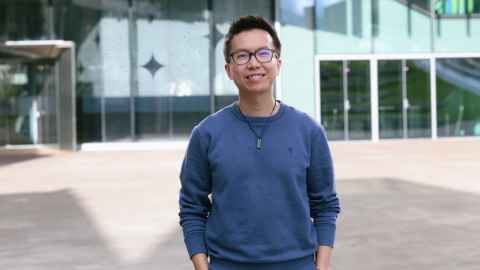Take 10 with... Yun Suen Pai
Dr Yun Suen Pai from the School of Computer Science gives us 10 minutes of his time to discuss how technology can empower people achieve what they want, despite existing limitations.

1. Describe your research topic to us in 10 words or less.
Tech that adapts and empowers people towards a prosocial society.
2. Now explain it in everyday terms!
I work on technologies that understand people, such as how they feel, think and behave, using things like brainwaves, heart rate or movement. Then I design tools that assist them in their everyday lives – whether that’s calming anxiety, improving communication or helping during stressful situations like emergencies. Finally, I explore ways to augment human abilities; not to replace people, but to help them thrive in ways that work for them. It’s like building a bridge to close social and ability gaps, overcoming our limitations.
3. Describe some of your day-to-day research activities.
It’s a mix of designing prototypes, running experiments, talking to communities, wrangling biosignal data, writing way too many grant applications and trying to stop (but sometimes, still encourage!) my students from overengineering everything. Oh, and sometimes getting unexpectedly excited over sensor readings that finally make sense.
4. What do you enjoy most about your research?
Co-designing sessions where we sit down with stakeholders to design a system together. There’s something incredibly rewarding about building something with someone, not just for them. Those “aha!” moments when a participant lights up because the technology actually works for them, that’s the real magic.
5. Tell us something that has surprised you in the course of your research.
Humans are surprisingly good at adapting to new ways of interacting, even ones that initially feel strange, as long as they’re not uncomfortable. Once, I built a quirky prototype that let me move through virtual space just by rotating my head. No controllers and no walking, just head turns. After a while it felt so natural that when I took the headset off, I instinctively started turning my head, expecting my body to follow. It was a weird (and slightly embarrassing) moment, but it reminded me just how fluid and adaptable our sense of interaction can be.
6. How have you approached any challenges you’ve faced in your research?
By making a lot of mistakes, crying about it for a day, wiping away the tears and moving on. Honestly, I’ve found the best way to grow is to get things wrong first, then figure out why. It’s okay to feel frustrated or down, we all do, just don’t let it stop you. Learn, reset and try again (maybe with better snacks the second time).
7. What questions have emerged as a result?
As I strive to design technology that can understand, assist and augment diverse individuals, I often ask ‘what would the world look like if everyone could fully participate, regardless of ability or neurotype?’
8. What kind of impact do you hope your research will have?
I want to build a truly inclusive, prosocial society, where diverse people can achieve what they want despite existing limitations. Where a neurodivergent teen or an elderly person with mobility issues can use tech not just to cope, but to thrive, express themselves and connect meaningfully with others.
9. If you collaborate across the faculty or University, or even outside the University, who do you work with and how does it benefit your research?
I collaborate with engineers, neuroscientists, designers, psychologists and community organisations – sometimes all in one project! These partnerships are where the real innovation happens. They stretch my thinking, keep me accountable to real-world needs and make sure what I build doesn’t live in a research vacuum.
10. What one piece of advice would you give your younger, less experienced research self?
Go out into the world. Talk to people. Listen deeply to their struggles, their needs and their stories. Invest in anything, whether it be experiences, tools or perspectives that train your mind to think beyond what’s right in front of you. That’s where meaningful research begins.